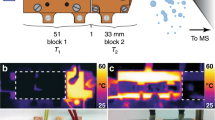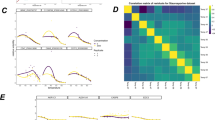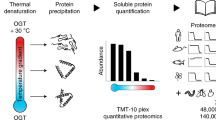Abstract
Thermodynamic stability is fundamental to the biology of proteins. Information on protein stability is essential for studying protein structure and folding and can also be used indirectly to monitor protein-ligand or protein-protein interactions. While clearly valuable, the experimental determination of a protein's stability typically requires biophysical instrumentation and substantial quantities of purified protein, which has limited the use of this technique as a general laboratory method. We report here a simple new method for determining protein stability by using pulse proteolysis with varying concentrations of denaturant. Pulse proteolysis is designed to digest only the unfolded proteins in an equilibrium mixture of folded and unfolded proteins that relaxes on a time scale longer than the proteolytic pulse. We used this method to study the stabilities of Escherichia coli ribonuclease H and its variants, both in purified form and directly from cell lysates. The ΔGunf° values obtained by this technique were in agreement with those determined by traditional methods. We also successfully used this method to monitor the binding of maltose-binding protein to maltose, as well as to rapidly screen cognate ligands for this protein. The simplicity of pulse proteolysis suggests that it is an excellent strategy for the high-throughput determination of protein stability in protein engineering and drug discovery applications.
This is a preview of subscription content, access via your institution
Access options
Subscribe to this journal
Receive 12 print issues and online access
$259.00 per year
only $21.58 per issue
Buy this article
- Purchase on Springer Link
- Instant access to full article PDF
Prices may be subject to local taxes which are calculated during checkout




Similar content being viewed by others
References
Pace, C.N. Conformational stability of globular proteins. Trends Biochem. Sci. 15, 14–17 (1990).
Lim, W.A. & Sauer, R.T. Alternative packing arrangements in the hydrophobic core of lambda repressor. Nature 339, 31–36 (1989).
Matouschek, A., Kellis, J.T., Jr ., Serrano, L. & Fersht, A.R. Mapping the transition state and pathway of protein folding by protein engineering. Nature 340, 122–126 (1989).
Greene, R.F. & Pace, C.N. Urea and guanidine-hydrochloride denaturation of ribonuclease, lysozyme, α-chymotrypsin, and β-lactoglobulin. J. Biol. Chem. 249, 5388–5393 (1974).
Pace, C.N., Shirley, B.A. & Thomson, J.A. Measuring the conformational stability of a protein in Protein Structure (ed. Creighton, T.E.) 311–330 (IRL Press, New York, 1989).
Linderstrøm-Lang, K. Structure and enzymatic break-down of proteins. Cold Spring Harb. Symp. Quant. Biol. 14, 117–126 (1950).
Ottesen, M. Induction of biological activity by limited proteolysis. Annu. Rev. Biochem. 36, 55–76 (1967).
Anfinsen, C.B. & Scheraga, H.A. Experimental and theoretical aspects of protein folding. Adv. Protein Chem. 29, 205–300 (1975).
Pace, C.N. & Barrett, A.J. Kinetics of tryptic hydrolysis of the arginine-valine bond in folded and unfolded ribonuclease T1. Biochem. J. 219, 411–417 (1984).
Imoto, T., Yamada, H. & Ueda, T. Unfolding rates of globular proteins determined by kinetics of proteolysis. J. Mol. Biol. 190, 647–649 (1986).
Sieber, V., Plückthun, A. & Schmid, F.X. Selecting proteins with improved stability by a phage-based method. Nat. Biotechnol. 16, 955–960 (1998).
Park, C. & Marqusee, S. Probing the high energy states in proteins by proteolysis. J. Mol. Biol. 343, 1467–1476 (2004).
Dabora, J.M. & Marqusee, S. Equilibrium unfolding of Escherichia coli ribonuclease H: Characterization of a partially folded state. Protein Sci. 3, 1401–1408 (1994).
Keil, B. Specificity of Proteolysis, (Springer-Verlag, New York, 1992).
Heinrikson, R.L. Applications of thermolysin in protein structural analysis. Methods Enzymol. 47, 175–189 (1977).
Myers, J.K., Pace, C.N. & Scholtz, J.M. Denaturant m values and heat capacity changes: Relation to changes in accessible surface areas of protein unfolding. Protein Sci. 4, 2138–2148 (1995).
Ghaemmaghami, S., Fitzgerald, M.C. & Oas, T.G. A quantitative, high-throughput screen for protein stability. Proc. Natl. Acad. Sci. USA 97, 8296–8301 (2000).
Schellman, J.A. Macromolecular binding. Biopolymers 14, 999–1018 (1975).
Pace, C.N. & McGrath, T. Substrate stabilization of lysozyme to thermal and guanidine hydrochloride denaturation. J. Biol. Chem. 255, 3862–3865 (1980).
Powell, K.D. et al. A general mass spectrometry-based assay for the quantitation of protein-ligand binding interactions in solution. J. Am. Chem. Soc. 124, 10256–10257 (2002).
Marvin, J.S. & Hellinga, H.W. Manipulation of ligand binding affinity by exploitation of conformational coupling. Nat. Struct. Biol. 8, 795–798 (2001).
Telmer, P.G. & Shilton, B.H. Insights into the conformational equilibria of maltose-binding protein by analysis of high affinity mutants. J. Biol. Chem. 278, 34555–34567 (2003).
Martineau, P., Szmelcman, S., Spurlino, J.C., Quiocho, F.A. & Hofnung, M. Genetic approach to the role of tryptophan residues in the activities and fluorescence of a bacterial periplasmic maltose-binding protein. J. Mol. Biol. 214, 337–352 (1990).
Parsell, D.A. & Sauer, R.T. The structural stability of a protein is an important determinant of its proteolytic susceptibility in Escherichia coli. J. Biol. Chem. 264, 7590–7595 (1989).
Arnold, U. & Ulbrich-Hofmann, R. Kinetic and thermodynamic thermal stabilities of ribonuclease A and ribonuclease B. Biochemistry 36, 2166–2172 (1997).
Ghaemmaghami, S. & Oas, T.G. Quantitative protein stability measurement in vivo. Nat. Struct. Biol. 8, 879–882 (2001).
Creighton, T.E. Electrophoretic analysis of the unfolding of proteins by urea. J. Mol. Biol. 129, 235–264 (1979).
Raschke, T.M., Kho, J. & Marqusee, S. Confirmation of the hierarchical folding of RNase H: A protein engineering study. Nat. Struct. Biol. 6, 825–831 (1999).
Spudich, G., Lorenz, S. & Marqusee, S. Propagation of a single destabilizing mutation throughout the Escherichia coli ribonuclease HI native state. Protein Sci. 11, 522–528 (2002).
Inouye, K., Kuzuya, K. & Tonomura, B. Sodium chloride enhances markedly the thermal stability of thermolysin as well as its catalytic activity. Biochim. Biophys. Acta 1388, 209–214 (1998).
Gill, S.C. & von Hippel, P.H. Calculation of protein extinction coefficients from amino acid sequence data. Anal. Biochem. 182, 319–326 (1989).
Laemmli, U.K. Cleavage of structural proteins during the assembly of the head of bacteriophage T4. Nature 227, 680–685 (1970).
Acknowledgements
We thank J.A. Blair for technical help with the cloning of MBP and the Bustamante lab for the use of their Typhoon imaging system. This work was supported by National Institutes of Health grant GM50945.
Author information
Authors and Affiliations
Corresponding author
Ethics declarations
Competing interests
The authors declare no competing financial interests.
Rights and permissions
About this article
Cite this article
Park, C., Marqusee, S. Pulse proteolysis: A simple method for quantitative determination of protein stability and ligand binding. Nat Methods 2, 207–212 (2005). https://doi.org/10.1038/nmeth740
Received:
Accepted:
Published:
Issue Date:
DOI: https://doi.org/10.1038/nmeth740
This article is cited by
-
Folding of newly translated membrane protein CCR5 is assisted by the chaperonin GroEL-GroES
Scientific Reports (2015)
-
Affinity purification in target identification: the specificity challenge
Archives of Pharmacal Research (2015)
-
Glutamate 85 and glutamate 228 contribute to the pH-response of the soluble form of chloride intracellular channel 1
Molecular and Cellular Biochemistry (2015)
-
False-Positive Rate Determination of Protein Target Discovery using a Covalent Modification- and Mass Spectrometry-Based Proteomics Platform
Journal of the American Society for Mass Spectrometry (2014)
-
SILAC-Pulse Proteolysis: A Mass Spectrometry-Based Method for Discovery and Cross-Validation in Proteome-Wide Studies of Ligand Binding
Journal of the American Society for Mass Spectrometry (2014)



